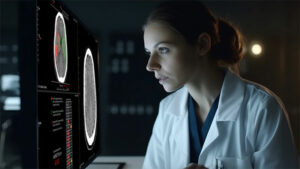Assistant Professor of Radiology at UC Irvine School of Medicine, Jennifer Soun graduated in 2008 in psychology and neuroscience at Princeton University. Dr. Soun is a board-certified UCI Health diagnostic radiologist who specializes in neuroradiology. Her clinical interests include stroke and vascular imaging. She earned her medical degree at Wake Forest School of Medicine in Winston-Salem, NC. She completed a residency in diagnostic radiology at New York Presbyterian-Columbia University Medical Center in New York City, followed by a fellowship in neuroradiology at Massachusetts General Hospital in Boston. During the ISC (International Stroke Conference) 2020 seminar we had the opportunity to meet and discuss AI in clinical practice.
What are the advantages you see in A.I. in your clinical practice?
AI in my clinical practice is very helpful and has a lot of potential for different things. One major thing is triaging of patients, for example, detecting hemorrhage and being able to put those cases higher up on a list of studies that we read.
“ I don’t see AI replacing radiologists, I see it as a very helpful tool assistant to the radiologists. ”
Do you think that specificity or sensitivity should be taken more into account in AI products, such as false negative and positive detection?
These measures definitely should be considered carefully when evaluating an AI tool. False negatives can be dangerous. For example, missing a large vessel occlusion is worse than overcalling it because an LVO is a treatable lesion. If left untreated, the patient may have significant morbidity.
However, there are more nuanced situations where a false negative may not be clinically significant. For example, if a tiny intracranial hemorrhage is missed, it may be within acceptable limits since a subtle ICH may not be as clinically significant. It’s important to have a balance between specificity and sensitivity.
What is the impact of false positives on workflow?
Having too many false positives can be a problem because, then you can’t trust the AI tool to work effectively, and the radiologist is less likely to even use it. Too many false positives may increase the time that the radiologist spends on a study, which would defeat the purpose of using AI as a fast triage tool. Regardless, the radiologist’s interpretation would need to confirm the final decision-making. Despite these challenges, we remain optimistic as more and more companies bring new solutions combining optimal specificity and sensitivity that could significantly improve radiologists’ workflow and triaging.



